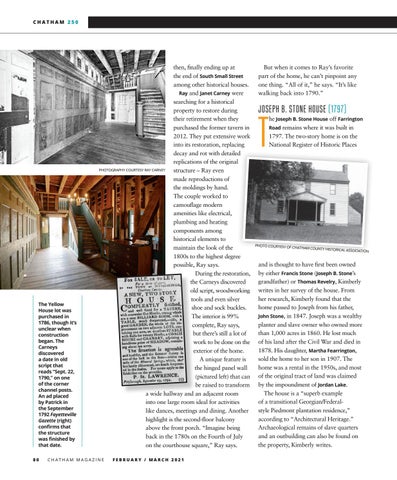CHATHAM 250
The Yellow House lot was purchased in 1786, though it’s unclear when construction began. The Carneys discovered a date in old script that reads “Sept. 22, 1790,” on one of the corner channel posts. An ad placed by Patrick in the September 1792 Fayetteville Gazette (right) confirms that the structure was finished by that date. 80
then, finally ending up at the end of South Small Street among other historical houses. Ray and Janet Carney were searching for a historical property to restore during their retirement when they purchased the former tavern in 2012. They put extensive work into its restoration, replacing decay and rot with detailed replications of the original PHOTOGRAPHY COURTESY RAY CARNEY structure – Ray even made reproductions of the moldings by hand. The couple worked to camouflage modern amenities like electrical, plumbing and heating components among historical elements to maintain the look of the 1800s to the highest degree possible, Ray says. During the restoration, the Carneys discovered old script, woodworking tools and even silver shoe and sock buckles. The interior is 99% complete, Ray says, but there’s still a lot of work to be done on the exterior of the home. A unique feature is the hinged panel wall (pictured left) that can be raised to transform a wide hallway and an adjacent room into one large room ideal for activities like dances, meetings and dining. Another highlight is the second-floor balcony above the front porch. “Imagine being back in the 1780s on the Fourth of July on the courthouse square,” Ray says.
CHATHAM MAGAZINE
FEBRUARY / MARCH 2021
But when it comes to Ray’s favorite part of the home, he can’t pinpoint any one thing. “All of it,” he says. “It’s like walking back into 1790.”
JOSEPH B. STONE HOUSE (1797)
T
he Joseph B. Stone House off Farrington
Road remains where it was built in
1797. The two-story home is on the National Register of Historic Places
PHOTO COURTESY OF CHATHAM COUNTY HIST ORICAL
ASSOCIATION
and is thought to have first been owned by either Francis Stone (Joseph B. Stone’s grandfather) or Thomas Revelry, Kimberly writes in her survey of the house. From her research, Kimberly found that the home passed to Joseph from his father, John Stone, in 1847. Joseph was a wealthy planter and slave owner who owned more than 1,000 acres in 1860. He lost much of his land after the Civil War and died in 1878. His daughter, Martha Fearrington, sold the home to her son in 1907. The home was a rental in the 1950s, and most of the original tract of land was claimed by the impoundment of Jordan Lake. The house is a “superb example of a transitional Georgian/Federalstyle Piedmont plantation residence,” according to “Architectural Heritage.” Archaeological remains of slave quarters and an outbuilding can also be found on the property, Kimberly writes.
